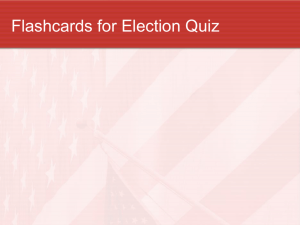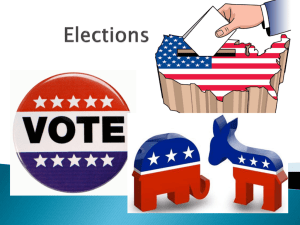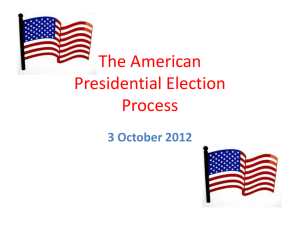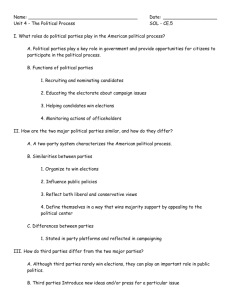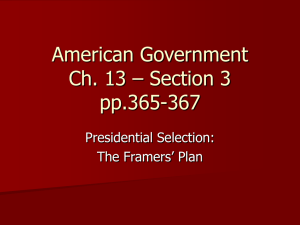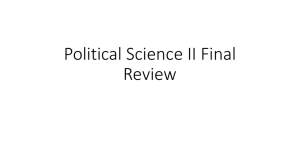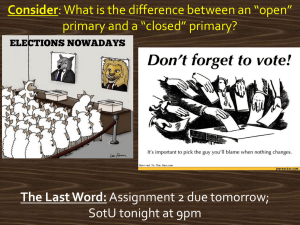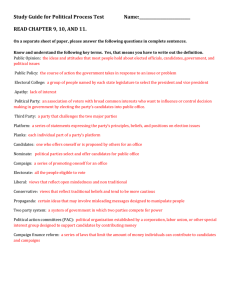ap government - West Ada School District
advertisement
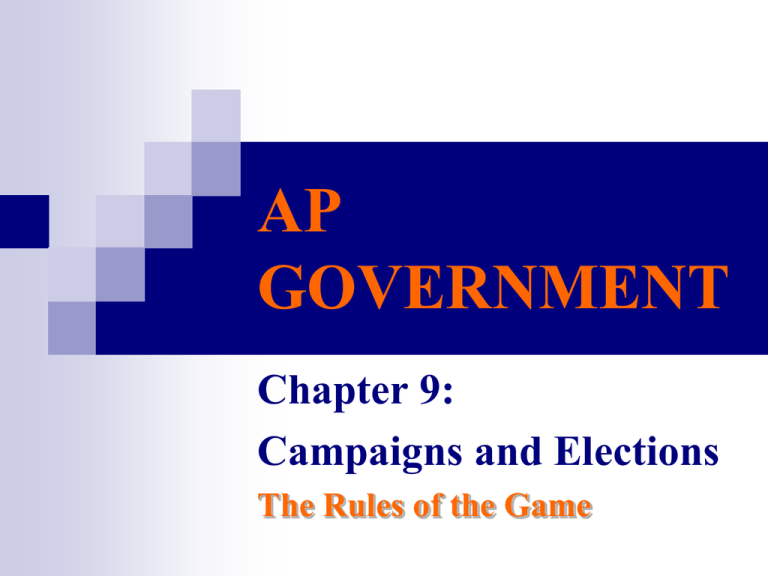
AP GOVERNMENT Chapter 9: Campaigns and Elections The Rules of the Game Elections: Rules of the Game The Constitution sets some electoral conditions and requirements Most details left up to states Representatives, Senators, and Presidents have fixed terms Representatives = 2 years Senators = 6 years President = 4 years Term Limits 22nd Amendment – President has a 2 term limit Lame Duck – candidate who can’t or won’t run again ¾ of voters favor term limits, especially state offices Federal term limits are unconstitutional U.S. Term Limits Inc. v. Thornton (1995) Constitutional amendment would be required 17 states have enacted term limits for their state legislatures and even more states limit the term of governors Idaho has no term limits Winner Take All Most American elections are based on a plurality Moderate candidates most common because they are more likely to secure a plurality or majority Vote for a third party candidate is a “wasted vote” and may help elect the voter’s least desired candidate Most American electoral districts are singlemember districts – in a district voter’s choose one representative or official Single member district + winner take all = 3rd parties DON’T WIN Proportional Representation Political parties receive a portion of seats = to the % of vote they receive in the election Party A = 50% Party B = 40% Party C = 10% Rewards minor parties and permits them to participate in government Examples: Germany, Israel, and Japan Running for Congress Most Congressional elections are not close Safe Seats are those seats dominated by one party House seats are often less competitive than Senate races Availability of campaign funds President, senate and governor races much closer effect – boost given to candidates by popular candidates for higher offices Midterm elections – presidential popularity & economic conditions Coattail House Elections 2 year terms Up to 1,000 candidates incl. ~ 400 incumbents Possibly unopposed Primary 1st step - Raise hundreds of thousands of dollars Build personal organization #1 hurdle is to gain visibility General Election 95% of incumbents win Incumbents outspend challengers 3 to 1 Remember incumbent advantage (bellringer) Senate Elections 6 year terms 1/3 elected every 2 years Continuous body Incumbency is less important in Senate races Potentially cost millions of $ https://www.youtube.com/watch?v=QBfx95frNDc Advantages of Proportional Representation More accurately reveals the preferences of voters and gives those who do not vote for the winning candidate a sense that they have some influence as a result of their vote Could encourage greater voter turnout Encourage issue-oriented campaigns and enhance the representation of women and minorities Disadvantages Makes it harder to have a clear winner, especially if minor parties are likely to receive representation It may contribute to political instability and ideological extremism Example on Israel (pg. 168) ELECTING THE PRESIDENT 3 Stages of Presidential Election 1. 2. 3. Nomination - States are assigned # of delegates and must decide how to assign them National Convention - President & VP candidates picked - Platform announced General Election - Electoral College video Stage 3: The Electoral College President & VP are elected through indirect device, not popular election Electors = Reps + Senators Total (Idaho – 4) State legislature chooses how its electors are selected Each party nominates a slate (list) of electors Electors are expected to cast their votes for the party’s candidates for Pres. and VP 538 “faithless elector” No faithless elector has ever cast the deciding vote Stage 3: The Electoral College How it works Election of electors in November Winner-take-all (except NE and ME) Electors go to state capital on the first Monday after the second Wednesday in December to cast their votes Ballots are sent to Congress in January January - Congress formally counts and declares the winner – 270 to win No majority winner – the House of Reps. chooses from the top 3 candidates – each state gets 1 vote President 1800 (Jefferson and Burr) – 12th Amendment 1824 (John Q. Adams, Andrew Jackson and William Crawford) – Senate chooses from top 2 candidates with each senator casting a vote V.P. Winning Most the popular vote? “popular” candidate may not win Andrew Jackson/ John Quincy Adams 1824 Samuel Tilden/ Rutherford B. Hayes 1876 Grover Cleveland/ Benjamin Harrison 1888 Al Gore/ George W. Bush 2000 How to win Appeal to voters in big states like California, New York, Texas, Florida, Illinois, and Ohio Battleground States - Emphasize states where race is close, even if small population Don’t waste time campaigning in a state unless they have a fighting chance to win the state or if their party is a sure winner Nixon was last to campaign in all 50 states (1960) Is the system broken or does it work adequately? Campaign Finance Reform https://www.youtube.com/watch?v=k5kHACjrdEY http://www.c-span.org/video/?304267-5/role-federal-electioncommission http://www.c-span.org/video/?317224-4/efforts-update-voting-rightslegislation

